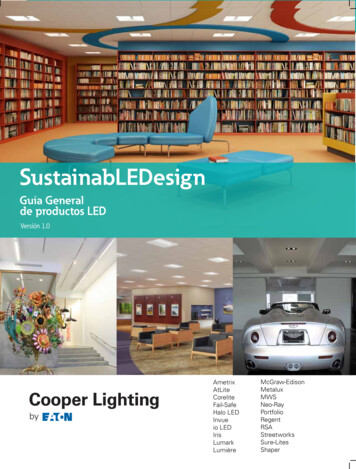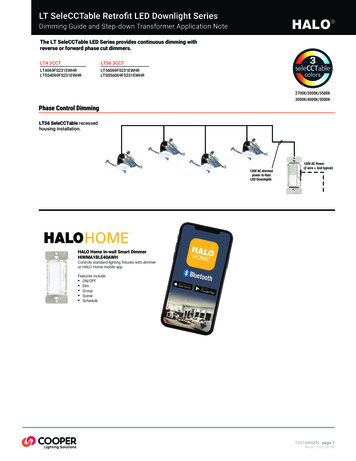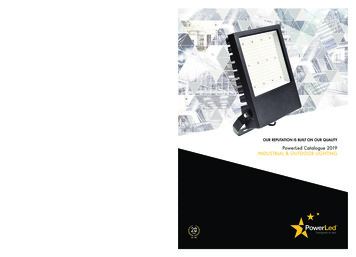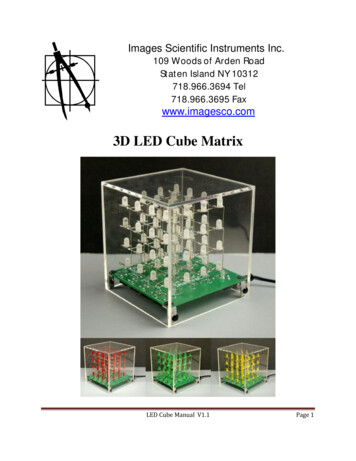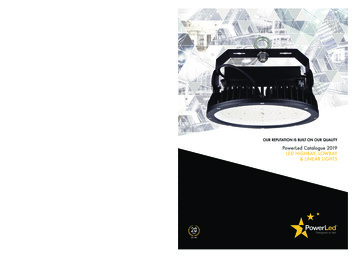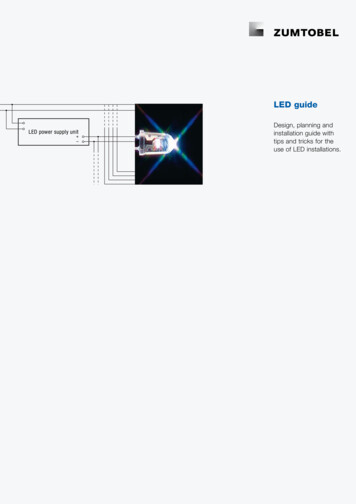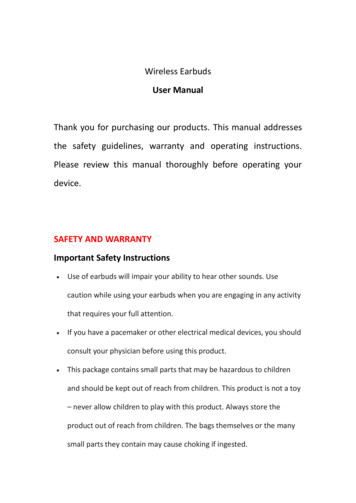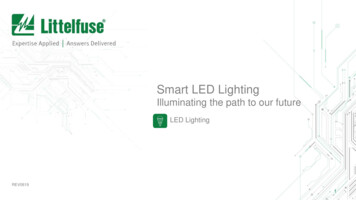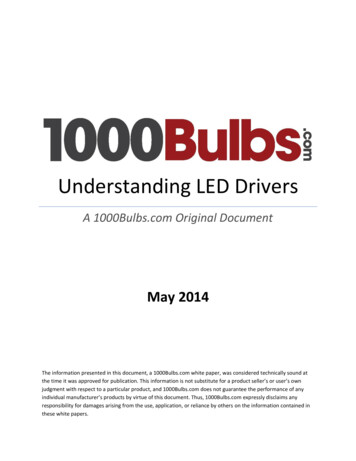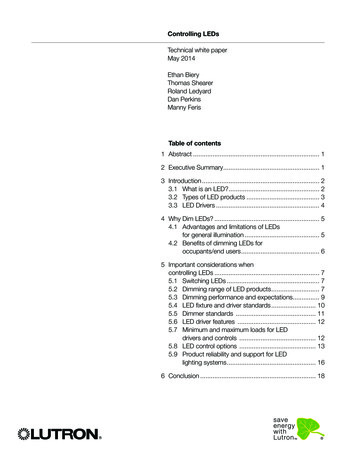
Transcription
Controlling LEDsTechnical white paperMay 2014Ethan BieryThomas ShearerRoland LedyardDan PerkinsManny FerisTable of contents1 Abstract 12 Executive Summary 13 Introduction 23.1 What is an LED? 23.2 Types of LED products 33.3 LED Drivers 44 Why Dim LEDs? 54.1 Advantages and limitations of LEDsfor general illumination 54.2 Benefits of dimming LEDs foroccupants/end users 65 Important considerations whencontrolling LEDs 75.1 Switching LEDs 75.2 Dimming range of LED products 75.3 Dimming performance and expectations 95.4 LED fixture and driver standards 105.5 Dimmer standards 115.6 LED driver features 125.7 Minimum and maximum loads for LEDdrivers and controls 125.8 LED control options 135.9 Product reliability and support for LEDlighting systems 166 Conclusion 18
1 AbstractTen years ago, Light Emitting Diodes (LEDs) were used primarily in niche applications as statusindicators, and in exit signs. Today, they’re designed into nearly every lighting application from streetlights to stairwells. However, owners, contractors, engineers and designers do not always know howto control LEDs or they have had a negative experience. Additionally, the fast-moving state of the LEDlighting industry means there is a lot of risk that needs to be managed throughout a job. This whitepaper provides: An overview of LEDs and types of LED products Advantages and limitations of LEDs for general illumination Benefits of dimming LEDs for occupants/home owners Important considerations for dimming LEDsUnlike fluorescent loads, most LED products are inherently dimmable. However, the dimmingperformance can vary greatly from manufacturer to manufacturer, or even in different fixtures from thesame manufacturer.The overall goal of this paper is to help you to take advantage of rapidly advancing LED technology ina way that makes your projects more successful.2 Executive SummaryLED lighting technology is rapidly progressing, and it is very important to know how to control LEDs toensure success for the end user and to achieve energy savings.An LED is an electronic device (chip) that produces light when an electrical current is passed throughit. There are two distinct type of LEDs: the LED lamp (also called a LEDi or retrofit lamp) and the LEDfixture.LED drivers are low-voltage devices that convert the line-voltage 120/220/277 V power to thelow voltage needed for the LEDs, and may also interpret control signals to dim the LEDs. LEDdrivers come in either constant current or constant voltage. These two types of drivers are NOTinterchangeable, and it is the design of the LED load that determines which driver is appropriate. BothLED lamps and LED fixtures require LED drivers. Selecting the proper LED driver determines: The control type needed to dim the fixture The best possible dimming performance Potentially, the maximum operating lifetime of the LED productThere are many advantages to LEDs such as high efficacy (lumens per watt), product longevity, andlower heat load, and LED products are available in many sizes and shapes. Benefits of dimming LEDsfor end users and occupants are energy savings, space flexibility, enhanced safety, and increasedproductivity. 1 Lutron
You can either switch or dim LEDs, depending on the use of the space. If dimming is preferredimportant considerations include: Dimming range of LED products (100 to 20% vs. 100 to 1%) Dimming performance and expectations (smooth, continuous, flicker-free) LED fixture and driver standards Dimmer standards LED driver features Minimum and maximum loads for LED drivers and controlsThere are many control options when it comes to LEDs, with the most common options being: Two-wire forward phase Two-wire reverse phase 3-wire forward phase 0-10 V EcoSystem digital DALI digital DMX-512Once these considerations are addressed and the control type is determined, it is then importantto consider the components (and subcomponents) of the system and how defective product andperformance issues will be resolved.After the system is up and running, the expected life and the long-term support of all the componentsbecomes the critical factor.3 Introduction3.1 What is an LED?A Light Emitting Diode (LED), also referred to as SSL (Solid State Lighting), is an electronic device(chip) that produces light when an electrical current is passed through it. The wavelength (or color) oflight that is emitted is dependent on the LED materials. LEDs are available in many colors, includingred, blue, amber, green, and near-UV colors, with lumen outputs ranging from 10 lumens to 200lumens per watt.For signage, TVs and theatrical applications, Red/Green/Blue (RGB) LEDs are each combined invarying intensities to create any visible color.The LEDs used predominantly in general illumination architectural applications are “PhosphorConverted Blue” LEDs - blue LEDs that have a yellow phosphor placed over the LED. The phosphorabsorbs some of the blue light, and emits light in the yellow, green, and red portions of the spectrum. 2 Lutron
When the unabsorbed blue light mixes with the other colors of light it creates what your eyeperceives as “white” light. The choice of blue LED and yellow phosphor, and the method of placingthe phosphor, creates hundreds of colors of “white” due to differences in color temperature and CRI(Color Rendering Index).A single LED chip is mounted with other chips, in many different forms, to create LED modules (alsoknown as LED Arrays, LED Engines, or LED Tapes).3.2 Types of LED productsThere are two distinct types of LED lighting: the LED lamp (also called a LEDi or retrofit lamp) and theLED fixture.LED lamps typically have screw-in, Edison-base sockets meant to replace standard incandescent orscrew-in CFL lamps. There are also LED lamps to replace other sources used in chandeliers or accentlights. In all cases, the bases of these lamps have integral drivers that determine whether or not thelamp is dimmable, and also determine dimming performance.LED lamp moduleIntegrated driverControlDimming or switchingLampFIGURE 1: LEDi (LED retrofit lamp) and control must be compatibleLED fixtures vary from cove lights to down lights to pendant lights and troffer fixtures, and they usuallyhave a driver mounted within the housing or remote from the LED source. Fixture manufacturersusually offer different driver options (for the same fixture) to support different control technologies(phase-control vs. digital) or applications (dimmable vs. non-dimmable).LED driverControlDimming or switchingLED lamp moduleDownlightLuminaire (Fixture)FIGURE 2: LED fixture (with driver and LED lamp module) and control must all be compatible 3 Lutron
3.3 LED DriversLED chips are inherently low-voltage devices that need additional electronic components to convertthe line-voltage 120/220/277 V power to the low voltage needed for the LEDs. These electronicsmay also interpret control signals and dim the LEDs accordingly. These devices are referred to asLED drivers.LEDs are powered by one of two different types of drivers. LED driver outputs may be constantvoltage (usually 12 V or 24 V) or constant current (e.g. 350mA, 700mA or 1050mA). It is the fixturemanufacturer that chooses the driver type and configuration to match the electrical requirements ofthe LED module they chose to use in the fixtureConstant voltage drivers provide a fixed constant voltage to LED modules connected in parallel. Aconstant voltage driver is used in areas where you may have a variable amount of fixtures, such asa cove (LED tape) or under-cabinet light. These are similar, or sometimes identical, to electronic ormagnetic low voltage power supplies used as remote transformers for halogen strip lights in a cove(or those used with MR16 lamps/fixtures). They typically have 12 V or 24 V outputs, although otheroutput voltages are possible. Constant voltage drivers can only be dimmed via a PWM method. FIGURE 4: Constant voltage driver exampleConstant current drivers provide a constant current, such as 700mA, to a specific LED module that isdesigned to operate at that current level. This is great for a down light, sconce or other LED fixturesthat use only one LED module per driver (much like a fluorescent lamp with its associated ballast).Note that some drivers support multiple currents, making them more flexible when the manufacturer isdesigning a fixture. For constant current drivers, there are two different dimming methods for adjustingthe output current when dimming: pulse-width modulation (PWM) and constant-current reduction(CCR) (refer to Lutron Application Note 360 for more details).FIGURE 3: Constant current driver exampleConstant current and constant voltage drivers are NOT interchangeable, and it is the electricalrequirements and the design of the LED load that determines which driver is appropriate. Often thisis application-based, but it is still the configuration of the LEDs that determines if a constant currentor a constant voltage driver is needed. Drivers are sometimes manufactured to operate specific LED 4 Lutron
devices or modules, while others can be configured to operate most commonly available LEDs.Generally, it is up to the fixture manufacturer to specify the proper driver type to be used.The selection of an appropriate driver is not limited to just making sure it matches the LED modulebeing used. The driver is the primary component that determines the best-possible dimmingcapabilities of the LED lamp or fixture. Furthermore, the LED driver is one source of potentialfailure for the LED fixture. The long-life benefits of LEDs are significantly reduced if the driver is notspecifically designed for an equally long life.Beyond compatibility with the LED load, LED drivers must be selected to fit the mechanicalconstraints of the fixture. For example, Lutron’s LED drivers come in a variety of different form-factorsto fit a variety of different fixture types, regional practices, and applications:Compact K canJapanStick M canUL-listedEuropean4 Why Dim LEDs?4.1 Advantages and limitations of LEDs for general illuminationAdvantages High Efficacy: Measured in Lumens per Watt(LPW) LED-based lighting fixtures can achieveefficacies ranging from 25LPW to over 100LPW (up to 300LPW in some circumstances), comparedto a halogen/incandescent efficacy of 5-15LPW or a fluorescent efficacy of 5-90LPW. Longevity: LEDs can achieve useful lifetimes ranging from 25,000 hours to up to 100,000 hours,compared to 1000 hours for an incandescent or 15,000-40,000 hours for fluorescent. Lower BTU heat load: LEDs do not create IR (heat) radiation in the occupied space, and generateless heat overall than other light sources. Smaller size and format: LEDs are available in many sizes and shapes—allowing existing fixturesto be smaller and enabling totally new fixture types. LEDs do not contain hazardous materials: as compared to mercury in linear fluorescent orCFL lamps. 5 Lutron
Limitations Higher cost: High Brightness LEDs, necessary for general illumination, are expensive but dropping inprice. They also require electronic drivers to convert conventional AC voltage to discrete DC voltagesfor the LED modules. Color and color rendering: LEDs vary widely in apparent color (Color Temperature) and how theyaffect the color of objects and people in the space (Color Rendition). Color stability over time isanother potential limitation. Control-compatibility challenges: Due to the wide range of LED-based lighting product types,not all LED lamps are dimmable, and the ones that can be dimmed may be limited in dimmingperformance and system compatibility. In fact, lighting has become a “system” where the LEDmodule, the LED driver and the LED dimmer must be chosen by the lighting fixture manufacturers andthe design team with system compatibility in mind.4.2 Benefits of dimming LEDs for occupants/end usersControlling daylight or dimming an electric lighting source is very important, so that a restaurant,theater, residence, hotel lobby or presentation space can create the environment that the designerintended, and enhance the ambiance for the end user.Percent of Input Power100%806040200020406080100%Measured LightFIGURE 5: Power vs. Measured Light for a typical LED driverSimilar to fluorescent, incandescent, halogen and low-voltage lamps, dimming LEDs saves energy ata roughly 1:1 ratio. If you dim LEDs down to 50% of their light output you will save nearly 50% of yourenergy usage. Not only do you save by using a more efficient source, you save even more energy bydimming LEDs.Dimming LEDs also makes them run cooler, which extends the life of the electronic components ofthe driver, as well as the yellow phosphor on the LEDs. This will extend their life and increase theLED’s lumen maintenance (the slow decrease in light output over a light source’s lifetime). Research isongoing to better quantify the relationship of dimming LEDs and lifetime extension. 6 Lutron
Dimming LEDs offers many other benefits common to other lighting, including: Space Flexibility: Dimming control systems provide for space flexibility—what may be an officespace today could easily be converted into a call center tomorrow; or a gymnasium can be used asa theater or cafeteria just by adding dimming control for the lighting. Your home and your workplaceshould be designed to complement your needs. As your needs change throughout the day, yourlighting should adapt as well; bright enough to read a book, but dim enough for computer use.Whether you are at home or at work, lighting control can create a comfortable atmosphere to supportyour activities throughout the day. If daylight is available, the LEDs can be dimmed to save even moreenergy. Enhanced Safety: Lighting controls can enhance the safety and security of your office and home byautomatically dimming or raising light levels upon entering a stairwell or hallway. Security systems orfire alarm systems can turn on lights in case of an emergency. You can also control both interior andexterior lights from the car as you approach your driveway to ensure optimal visibility and comfort. Increased Productivity: Lighting control can increase productivity by allowing the user to select theright level needed for varying tasks, and reduce eye strain and fatigue. Proper lighting enhances yourability to work at peak performance for more of the day, or allows students to focus more effectivelyat school.5 Important Considerations when Controlling LEDs5.1 Switching LEDsThe most basic form of control is line-voltage switching. Switching can be used in energymanagement systems with occupancy and daylight sensing. Fixtures or zones supplied with multiplecontrol circuits can also utilize multi-level switching. In a multi-level switching installation, portions ofa fixture or zone of lights can be turned off or on based on the needs of the space. Since an abrupton/off of the illumination is associated with switching, it is primarily utilized in applications whereadjustable light levels or particular aesthetics are not required, e.g. a warehouse.5.2 Dimming range of LED productsAll incandescent lamps dim well below one percent perceived light, which looks like an orangefilament glow, and this sets the expectation for all dimmed light sources. Conversely, the dimmingrange of an LED lamp or fixture can vary greatly from one device to another.Some LEDs may dim to a minimum level of only 20%, while a different product may dim to 1%.Additionally, manufacturers will quote measured light levels, e.g. 10%, but consumers are not familiarwith perceived light. What is the difference? Measured light output is the quantifiable value of light (measured in foot-candles) by a light meter orsimilar device. This is the dimming ratio percentage indicated on LED product specification sheets. Perceived light is the amount of light that your eye interprets as a result of pupil dilation. The eye’spupil dilates at lower light levels, causing the amount of light to be perceived higher than measured 7 Lutron
(e.g., 20 percent measured light equals 45 percent perceived light). The equation for determiningperceived light is the square root of the measured light percentage (e.g. 0.20 0.45).As the designer or the end-user, you need to select the dimming range of your fixture or lamp thatwill be suitable for your application. A product that dims to 20 percent measured light (45 percentperceived) may be the energy-saving solution necessary for the daylight harvesting strategy needed inan office, but 20% dimming wouldn’t make sense in an Audio/Visual media room where 1% dimmingis expected.1 % Architectural dimming5 % High performance dimming10 % Lighting management dimming100%90Formula: Perceived Light (%) 80100 xMeasured Light70Measured Light (%)10060504030FIGURE 6: Measured vs. Perceived Light20105101022223232405060708090100%Perceived LightIf an LED fixture spec sheet does not state the dimming range, you should contact the manufacturerfor that important piece of information. Lutron testing report cards (found at www.lutron.com/LEDTool)include perceived light as well as measured light, to provide all the information needed to aligncustomer expectations.It is important to understand that the dimming range of any LED product is based solely on the driver.The integral driver of a screw-in LED retrofit lamp and the external driver of an LED fixturewill determine how low the connected LED module is capable of dimming. Furthermore,different drivers may produce different dimming curves, even if they can dim to the same low-endlight level. Often, there is no guarantee that relative light levels will match between LED products fromdifferent manufacturers, even at the same dimmer level.The driver alone (whether internal to the lamp or an external driver) not only determines the lowestpossible low-end light level, but also the best possible dimming performance, whether it is smoothand continuous, or steppy and full of flicker.Finally, be aware that the dimming range of an LED product may vary based on what type ofdimming control is used. Using the wrong control, even if the driver is capable of providingoutstanding dimming performance, can lead to poor dimming quality due to incompatibilitybetween the driver and control. 8 Lutron
5.3 Dimming performance and expectationsThe public’s experience with incandescent dimming is that it is smooth and continuous. Specifically,any change in the control (dimmer) position should be reflected by an equal change in light level—there should be no abrupt changes in light level as the light source is being dimmed. Eachmanufacturer defines dimming in a different way, but the end user expects that the dimming will notbe distracting or have noticeable, irregular changes in light.Even more important is eliminating flicker in the dimming range. Flicker is the unexpected modulationof light level that is visible to the human eye. It is more susceptible in LEDs because of theextremely fast change in light output caused by the LED chip reacting to changes in input current inmicroseconds. Flicker can come from many sources, including line noise, control noise, componenttolerance and poor LED driver circuit design. Flicker can be continuous (happening all of the time), orintermittent (only happening some of the time or at certain light levels). A good driver should accountfor all of these internal and external factors and still provide flicker-free, smooth, continuous dimming.A properly designed LED dimming driver should not allow flicker at any time or any light level, nor haveany of the following additional problems: Pop-on: After being dimmed to a low light level and switched off, sometimes LED lamps or LEDdrivers will not turn on until the dimmer’s slider is moved up to 20, 30 or 40%. This is referred to as“pop-on,” which is especially challenging in 3-way situations where lights must be able to be turnedon/off from different locations, not just from the main dimmer. Drop-out: There should be no drop-out. The light should only turn off when the dimmer is turned off.This can be achieved by utilizing the low-end trim settings available on many wallbox and systemlevel dimmers to ensure that the lights remain on at their lowest light level at the bottom of the dimmertravel. Dead-travel: Adjusting the dimmer control without a corresponding change in light level isdisconcerting and undesirable. Audible Noise: Buzzing from the lamp, driver or dimmer is unacceptable. Shimmer: Small changes in light intensity, usually noticed at medium to low light levels, and oftenonly at the periphery of vision. Often, the terms flicker and shimmer are used interchangeably.Note that LED lighting, like fluorescent lighting, does not inherently change color when dimmed.Traditional incandescent and halogen lamps dim to a warm (more orange) color as they are dimmedto lower light levels. This is a result of the physical processes inherent in all incandescent lamps.Left unaddressed, some customers who are used to colors getting warmer when dimmed maybe dissatisfied with the static color of LEDs when dimmed. Therefore, some manufacturers aresimulating the performance of an incandescent load by mixing white, amber, or other colors, allowingthe LED lamp to mimic incandescent color changes as it dims. The effectiveness and methodologyof this simulation may vary widely from manufacturer to manufacturer. Mixing sources from multiplemanufacturers may provide inconsistent and undesired performance. 9 Lutron
5.4 LED Fixture and driver standardsCertification by a Nationally Recognized Testing Lab (NRTL), such as Underwriters Laboratories (UL),CSA, or Intertek, is an important aspect of ensuring the safety of any product, and LED luminaires areno different. Such certifications confirm that a fixture has passed standardized tests and establishesthat a product should not present any unexpected hazard upon installation.Many types of products are components that have been tested to a particular safetystandard, but are intended to be installed as part of a larger, finished assembly. Thesecomponents are considered “recognized” (such as “UL recognized”, abbreviated as RU).Finished products that are intended to be installed as stand-alone products are considered“Listed” (such as “UL Listed). Many LED drivers are tested and marked as a “recognized”component, because they are intended to be installed as part of a complete LED fixture(which would then get the “Listed” marking). In the past, fluorescent dimming ballasts were“UL Listed” and could be used in any fixture.The differentiation between Listed and Recognized components is important. In order to get a Listedmark on an end product, such as an LED fixture, not only does the manufacturer need to perform acomplete battery of tests (including, but not limited to, thermal tests), but they must also provide adetailed breakdown of many of the components that go into its construction, including Recognizedcomponents. This means that after the testing has been completed, the manufacturer is NOT free tomake a substitution from one Recognized component to another, if it was not included as part of theoriginal testing. For example, a manufacturer cannot replace one LED driver with a second driver ifthe second driver was not included in the test report on file with the NRTL being used. Furthermore,a driver cannot be substituted by the installer and still maintain the proper Listing of the end product.Different drivers may only be used if additional testing is done and records updated appropriately atthe NRTL.A recent change to LED fixture standards has been the introduction of a “TL” certification for LEDfixtures and drivers. This allows a fixture manufacturer to test its fixture to a particular temperaturestandard in conjunction with drivers that have a TL certification. If done properly, manufacturersthat have fixtures that meet the TL requirements can freely substitute drivers that also meet TLrequirements, with little or no additional testing or paperwork necessary. Increased market adoptionof products that meet TL requirements should enable fixture manufacturers to more easily offer a wideselection of different drivers that meet their customers’ needs. TL temperatures will be selected basedon UL concerns about safety—each driver manufacturer will select temperatures that best allow themto warranty their product.In certain fixtures, using a Recognized driver is not practical, as there is no complete fixture to getfully UL Listed. For example, LED strip or tape light comprises only of a driver, i.e. a power supply,and the LED load itself. In this case, a Listed LED driver is necessary. Again, this type of driver hasbeen tested to meet all the necessary safety certifications when used in a stand-alone configuration.This means that one Listed LED driver can be freely substituted by any other Listed LED driver, eitherby the manufacturer or the installer, as long as the proper output electrical specifications (voltage,current, power) are met. Besides LED tape light, Listed LED drivers may be desirable in manysituations where LED drivers are remote mounted and offered separately from the fixture. 10 Lutron
5.5 Dimmer standardsLike fixtures, dimming controls are tested to various standards developed and executed by NRTLs.Part of the testing for dimmers involves testing for specific load types, because different load typesare subject to different electrical stresses. For example, MLV loads are susceptible to overheatingif presented with non-symmetrical waveforms. Therefore, dimmers that are rated for MLV loads arespecially tested to ensure they don’t create asymmetrical waveforms. Dimmers that are designed onlyfor incandescent loads are not required to pass the symmetrical waveform test, and therefore maydamage any MLV loads that are connected.To prevent unsafe situations, the National Electric Code (NEC) requires that all dimmers be used onlywith the type of load they were designed, tested, and marked for use with. If a dimmer is not markedfor use with a particular load type, it must not be used on that load type. LED load types don’t fit theexisting profile of any existing load type for a variety of reasons: LED fixtures (screw-in lamps or fixtures with drivers) dimmed with phase-cut waveforms presentstresses to a dimmer that can exceed the stresses that would not be generated by an incandescentload. At best, this can cause premature failure of the load or control; at worst it can create an unsafesituation. The internal construction of LED lamps and drivers can vary widely. Two LED products of the samewattage can create two very different stresses on a control.Testing standards have not commonly defined a standardized LED load against which any dimmercan be tested. Instead, they have required dimmer manufacturers to test individual LED loads toensure the safe operation of the dimmer. Because of the differences in LED loads, positive testresults with one load cannot be generalized to many different loads.Because older incandescent-only phase-control dimmers were not tested or rated on newer LEDloads, their reliability and safety is unknown in those situations. Repeated testing has shown that LEDloads, in many cases, will cause higher stresses on a control than an incandescent load of the samewattage.Fortunately, most manufacturers have developed dimmers made especially for dimmable LED loads.These dimmers have been tested to properly and safely handle the additional stresses that LED loadsmay cause, and typically have LED load-specific ratings (such as 600W incandescent and 150WLED). Furthermore, they have been tested on many different LED loads, and the results are typicallypublicized as part of a compatibility list. A lack of an LED-specific load rating does not necessarilyimply that the control is not suitable for LED loads. Check with the control manufacturer or spec sheetto ensure that using the control with LEDs is allowed.There are few standards that exist regarding compatibility between drivers and LED loads. NEMASSL-7A is one standard which provides for basic interoperability between LED loads and phasecontrol dimmers. Using dimmers and lamps that are compliant with this voluntary standard willprovide some assurance of basic dimming performance. However, SSL-7A compliance alone isinsufficient to ensure the dimming performance will meet the needs and expectations of customers. 11 Lutron
5.6 LED Driver featuresThe nearly instantaneous response of LEDs to changing current makes them highly susceptible toflicker, especially compared to incandescent sources. One of the most important LED driver features(regardless of whether the driver is constant current or constant voltage) is the quality and consistencyof the DC output voltage of the driver.Remote mounting of a driver (mounting the driver external to the LED fixture, from ten to hundredsof feet away) could result in potential voltage drops, power losses, or noise susceptibility on
A single LED chip is mounted with other chips, in many different forms, to create LED modules (also known as LED Arrays, LED Engines, or LED Tapes) 3.2 Types of LED products There are two distinct types of LED lighting
